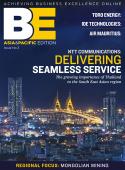Take the┬átrain, ease the pain┬áMinnesota prepares to welcome the stateÔÇÖs first commuter rail system. Climb aboard with April Terreri to learn more. Traffic-weary commuters traveling to and from work in downtown Minneapolis will soon be able to leave their cars behind and hop a train downtown. The North Star Commuter Line will be MinnesotaÔÇÖs first commuter rail line and will begin its first run toward the end of the year.One interesting thing about the new rail line is that it will operate on the existing Burlington Northern Santa Fe (BNSF) rail infrastructure, which has a rich heritage of serving our nation for over 100 years. The project is an innovative and cost-effective way to offer this commuter rail service while BNSF continues to run its freight service 24/7. The commuter rail service comprises a 40-mile line from Big Lake, Minnesota, right to the heart of downtown Minneapolis, and will serve five suburban stations and one downtown station. Trains will move up to 79 miles per hour, the maximum speed limit for passenger trains in that part of the country, explains Mark Fuhrmann, North Star project director.The $317.4 million project is the result of planning that began in 1997, reports Fuhrmann. ÔÇ£The North Star Commuter Rail project is a true partnership of public agencies,ÔÇØ he says, adding that he works for parent company, Metropolitan Council. ÔÇ£We partnered with the North Star Corridor Development Authority, which began pursuing this idea back in 1997. Our third partner is the Minnesota Department of Transportation, which has been taking the lead in the construction.ÔÇØAbout one-half of the project is being funded by the Federal Transit Administration, with another $99 million coming from the State of Minnesota and $51 million from the North Star Corridor Development Authority. The remaining funds are being provided by various local entities.Overall construction for the project comprises three major contracts. The first involves building the vehicle maintenance facility located at the end of the line in Big Lake. ÔÇ£This is where weÔÇÖll service and maintain our locomotives and coaches,ÔÇØ Fuhrmann says.The downtown Minneapolis contract involves construction of the downtown commuter rail station. ÔÇ£We also had to extend our light rail system four blocks to connect it with the new commuter rail system,ÔÇØ explains Fuhrmann. ÔÇ£This will allow passengers to exit the commuter rail and ride an escalator to connect with the light rail train to move about downtown Minneapolis and ride to places like MinneapolisÔÇôSt. Paul International Airport or to AmericaÔÇÖs largest mall, the Mall of America,ÔÇØ explains Fuhrmann.The final contract involves constructing the five suburban stations and their respective park-and-ride lots. About 85 percent of the overall projectÔÇÖs construction is completed. The cost for these three construction projects is $60 million.Metropolitan Council has already taken receipt of five locomotives and is beginning to receive the 18 passenger coaches that will comprise the commuter line fleet. The locomotives are remanufactured freight locomotives that have been stripped to their frames and then rebuilt. ÔÇ£This work was done by Motive Power, Inc. in Boise, Idaho,ÔÇØ Fuhrmann says.The 18 passenger coaches are being assembled by Bombardier Transportation Systems in Plattsburg, New York. ÔÇ£Because weÔÇÖre using federal dollars to purchase these vehicles, 51 percent of the value of the vehicles must be based on American investments under the Buy American rule.ÔÇØ The construction of the frames and car bodies is being done in Thunder Bay, Ontario, just north of the Minnesota border.As might be expected, a number of critical logistics challenges had to be overcome to accommodate BNSFÔÇÖs freight runs, the North Star commuter line, and even AmtrakÔÇÖs Empire BuilderÔÇöall of which use BNSFÔÇÖs rails along this 40-mile stretch. ÔÇ£The beauty of this arrangement is that BNSF controls all train movements from its dispatch center in Fort Worth,ÔÇØ Fuhrmann says. ÔÇ£From this center, BNSF monitors every train on every mile of its 40,000-mile network. They will place our commuter trains on that same network to manage, dispatch and control the safe movement of our trains.ÔÇØBNSF will continue to own and maintain the main line railroad. North Star negotiated a permanent easement from the railroad so it could run, in perpetuity, 12 commuter trains each weekday and six commuter trains each weekend day. ÔÇ£For this privilege, weÔÇÖll pay BNSF a one-time payment of $107.5 million, paid in five installments,ÔÇØ says Fuhrmann. North Star will pay BNSF for the cost of labor and fringe benefits for the BNSF engineer and conductor who will operate each of the North Star trains.The new commuter line will be a boon to the region, helping ease the heavy congestion and greenhouse gas emissions in the Highway 10 corridor north of downtown Minneapolis, reports Fuhrmann. ÔÇ£Our startup passenger forecast anticipates about 4,100 passenger trips per day, so that means about 2,000 cars will be taken off the highway every work day.ÔÇØEach coach has a capacity of 140 seated passengers. ÔÇ£WeÔÇÖll run four-car trains, with a seating capacity on each train of 560 people,ÔÇØ explains Fuhrmann. Trains will run every 30 minutes during peak periods, with five trains into the Twin Cities metro area during the morning hours and five out in the evening. ÔÇ£The commuter line will enable people to get to work faster while they snooze, read or use their BlackBerry for work. Because of the heavy congestion, it takes about an hour to make that 40-mile trip on a nice sunny day by automobile. With rain or bad weather, that trip can take up to two hours. And when it snows, it could take over three hours to get downtown. The beauty of North Star is that it will carry people downtown in only 45 minutes in any kind of weather; so it offers fast, reliable and cost-effective service.ÔÇØFuhrmann emphasizes that the project is being brought to fruition through partnerships at the federal, state and local levels. Even the Minnesota Twins went to bat for the project. The teamÔÇÖs new open-air ballpark, to open early next spring, is close to the downtown station. ÔÇ£So the Twins volunteered to constructÔÇöat their expense, and not at taxpayersÔÇÖ expenseÔÇöa vertical circulation or a system of elevators and escalators that will carry passengers from the commuter rail up to the light rail system on a raised bridge,ÔÇØ explains Fuhrmann. ÔÇ£Because our rail station is so close to their new ballpark project, the Twins included this in their construction project.ÔÇØWhen the first North Star train pulls out of the station, all the projectÔÇÖs partners will be aboard, notes Fuhrmann. ÔÇ£We will also invite many of our supporting federal, state and local elected officials, as well as BNSF officials from Texas.ÔÇØ ÔÇô Editorial research by Kevin Foss┬á









